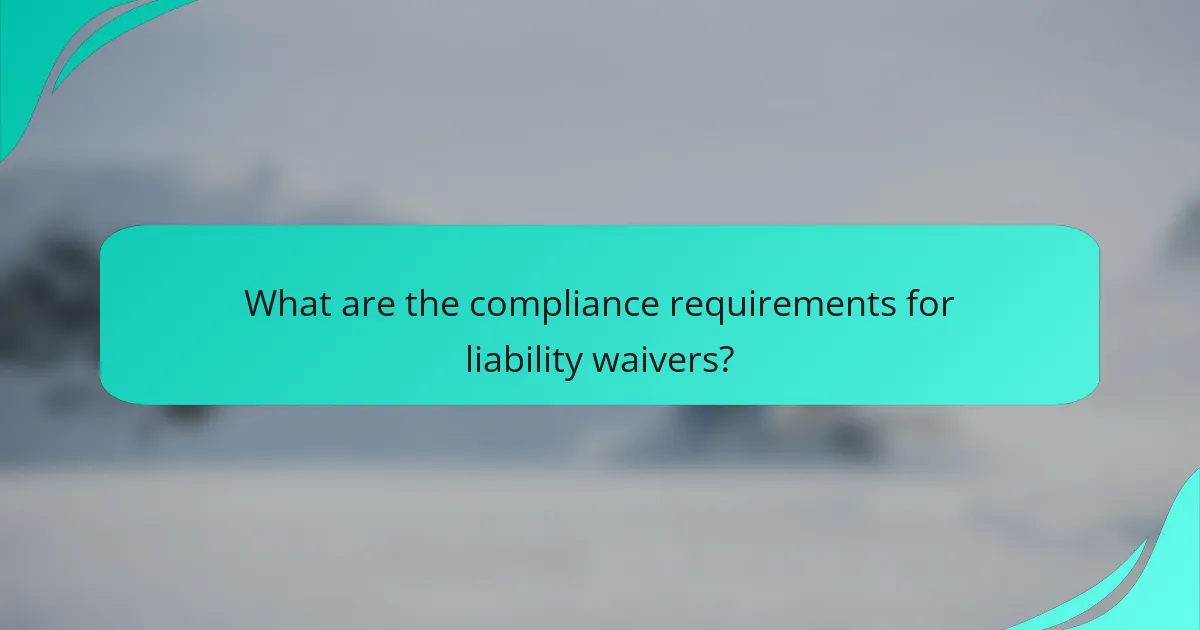Liability waivers are essential tools for businesses in the US, designed to limit legal responsibility for injuries or damages that may arise during their activities. When crafted and executed correctly, these waivers can significantly aid in risk management and help prevent costly legal disputes. However, compliance with jurisdictional requirements and awareness of potential risks are crucial to ensure their effectiveness and enforceability.

How do liability waivers protect businesses in the US?
Liability waivers protect businesses in the US by limiting their legal responsibility for injuries or damages that may occur during their activities. When properly drafted and executed, these waivers can serve as a crucial tool for risk management, helping businesses avoid costly lawsuits and claims.
Risk mitigation
Liability waivers significantly reduce the risk of legal claims against a business by clearly outlining the responsibilities of participants. By having customers acknowledge the risks associated with an activity, businesses can deter frivolous lawsuits and encourage individuals to take personal responsibility for their actions.
For example, a gym may require members to sign a waiver before using certain equipment, thereby reducing the likelihood of injury claims. This proactive approach can help businesses maintain a safer environment and minimize potential legal exposure.
Legal defense support
In the event of a lawsuit, a well-crafted liability waiver can provide strong legal defense support for businesses. Courts often uphold waivers if they are clear, specific, and voluntarily signed, which can lead to dismissal of claims or reduced liability.
Having a waiver in place can also streamline legal proceedings, as it serves as evidence that the participant was informed of the risks and agreed to assume them. This can save businesses time and resources during litigation.
Insurance premium reduction
Businesses that utilize liability waivers may experience reductions in their insurance premiums. Insurers often view waivers as a risk management strategy, which can lead to lower rates for coverage.
By demonstrating a commitment to safety and risk mitigation through waivers, businesses can negotiate better terms with their insurance providers. This can result in significant savings, especially for high-risk industries such as adventure sports or event hosting.

What are the compliance requirements for liability waivers?
Compliance requirements for liability waivers vary by jurisdiction but generally include adherence to state laws, clear language, and proper acknowledgment by the signatory. Ensuring these elements are met can help enforce the waiver and protect against legal claims.
State-specific regulations
Each state has its own regulations governing liability waivers, which can significantly impact their enforceability. For instance, some states may require specific language or disclaimers, while others may not recognize waivers for certain activities, such as those involving inherent risks. It’s crucial to consult local laws to ensure compliance.
Additionally, certain professions, such as healthcare or sports, may have stricter requirements for waivers. Understanding these nuances can help in drafting a waiver that holds up in court.
Language clarity and readability
Liability waivers must be written in clear and understandable language to be enforceable. Legal jargon or overly complex terms can lead to confusion, potentially rendering the waiver invalid. Aim for straightforward wording that clearly outlines the risks involved and the rights being waived.
Using plain language and a readable format, such as bullet points or short paragraphs, can enhance comprehension. Consider testing the waiver with individuals unfamiliar with legal documents to gauge clarity.
Signature and acknowledgment
For a liability waiver to be valid, it must be signed by the participant, indicating their acknowledgment of the risks and agreement to the terms. This signature should be obtained before the activity begins to ensure that the participant is fully informed.
Consider including a statement that confirms the participant understands the waiver and its implications. This can further strengthen the enforceability of the waiver in case of disputes.

What risks are associated with liability waivers?
Liability waivers carry several risks that can impact their effectiveness and enforceability. These risks include challenges to their enforceability, potential negligence claims, and the possibility of misinterpretation by clients.
Enforceability challenges
Liability waivers may face enforceability challenges based on jurisdictional laws and specific wording. Courts often scrutinize these documents to ensure they are clear, unambiguous, and not overly broad. For instance, waivers that attempt to absolve a party from liability for gross negligence may be deemed unenforceable.
To improve enforceability, ensure that the waiver is prominently displayed, clearly written, and signed voluntarily by the participant. Using plain language and avoiding legal jargon can help mitigate misunderstandings.
Potential for negligence claims
Even with a signed waiver, individuals may still file negligence claims if they believe their safety was compromised. Courts can allow claims if they find that the waiver does not adequately protect against reckless or intentional misconduct. This means that businesses must maintain a high standard of care to avoid liability.
To minimize the risk of negligence claims, organizations should implement safety protocols and training, regularly review their practices, and ensure that waivers are up-to-date with current regulations and standards.
Misinterpretation by clients
Clients may misinterpret the terms of a liability waiver, leading to disputes over its meaning and intent. If a waiver is too complex or vague, participants may not fully understand what rights they are relinquishing. This can result in dissatisfaction and potential legal action.
To prevent misinterpretation, provide a thorough explanation of the waiver’s content before obtaining signatures. Consider using bullet points to highlight key elements and encourage questions to clarify any uncertainties.

How to draft an effective liability waiver?
To draft an effective liability waiver, focus on clarity, essential clauses, and legal compliance. A well-structured waiver can protect your organization from legal claims while ensuring that participants understand their rights and responsibilities.
Clear and concise language
Using clear and concise language is crucial when drafting a liability waiver. Avoid legal jargon and complex sentences that may confuse the reader. Instead, use straightforward terms that clearly convey the waiver’s purpose and implications.
For example, instead of saying “I hereby release and discharge,” you might say “I release the organization from any responsibility for injuries.” This makes the intent of the waiver more accessible to all participants.
Inclusion of essential clauses
Essential clauses in a liability waiver typically include a clear statement of the risks involved, a release of liability, and an acknowledgment of understanding. These components ensure that participants are aware of the potential dangers and agree to waive their right to sue.
Consider including clauses that specify the scope of the waiver, such as whether it covers negligence or only intentional acts. This clarity helps prevent misunderstandings and strengthens the waiver’s enforceability.
Consultation with legal experts
Consulting with legal experts is vital when drafting a liability waiver to ensure compliance with local laws and regulations. Legal professionals can provide insights into specific requirements that may vary by jurisdiction, such as age restrictions or language mandates.
Additionally, a lawyer can help tailor the waiver to your specific activities and risks, increasing its effectiveness. This step can save you from costly legal disputes in the future, making it a worthwhile investment.

What are common misconceptions about liability waivers?
Liability waivers are often misunderstood, leading to incorrect assumptions about their effectiveness and applicability. Many believe they provide absolute protection against all claims, while others think they are only relevant for certain activities or universally enforceable.
They eliminate all liability
A common misconception is that liability waivers completely eliminate all liability for the party requiring the waiver. In reality, while they can limit liability for certain risks, they do not protect against gross negligence, intentional misconduct, or violations of public policy.
For example, if a business asks participants to sign a waiver before engaging in an activity, it may still be held liable if it fails to maintain a safe environment. Understanding the limitations of waivers is crucial for both providers and participants.
Only necessary for high-risk activities
Many people believe that liability waivers are only needed for high-risk activities like skydiving or extreme sports. However, waivers can also be beneficial for lower-risk activities, such as recreational classes or community events, where there is still potential for injury or disputes.
Even in low-risk scenarios, having a waiver can help clarify expectations and responsibilities, reducing the likelihood of misunderstandings. Businesses should assess their specific activities to determine if a waiver is appropriate, regardless of perceived risk levels.
They are universally enforceable
Another misconception is that liability waivers are universally enforceable across all jurisdictions. In fact, enforceability can vary significantly based on local laws and regulations, as well as the specific language used in the waiver.
Some jurisdictions may require waivers to meet certain legal standards to be valid, while others may not recognize them at all in specific contexts. It is essential for businesses to consult legal counsel to ensure their waivers comply with local laws and are likely to be upheld in court.

How do liability waivers differ by industry?
Liability waivers vary significantly across industries due to differing risks, regulations, and legal standards. Each sector tailors its waivers to address specific activities and potential liabilities, ensuring adequate protection for both providers and participants.
Sports and recreation
In the sports and recreation industry, liability waivers are commonly used to protect organizations from claims arising from injuries during activities. These waivers typically inform participants of inherent risks, such as falls or collisions, and require their acknowledgment of these risks before participation.
To be effective, waivers should be clear and specific, detailing the activities involved and the risks associated. For example, a waiver for a rock climbing gym might include language about falling rocks or equipment failure. It’s crucial to ensure that waivers comply with local laws, as some jurisdictions may have specific requirements regarding their enforceability.
Healthcare services
In healthcare, liability waivers serve to limit the liability of providers for certain risks associated with treatments or procedures. These waivers often require patients to acknowledge potential risks, such as side effects of treatments or the possibility of complications.
Healthcare waivers must be carefully crafted to comply with regulations, such as the Health Insurance Portability and Accountability Act (HIPAA) in the U.S., which protects patient information. Providers should ensure that patients fully understand what they are signing, as misunderstandings can lead to disputes. Clear communication and thorough explanations are essential to mitigate risks and enhance patient trust.
